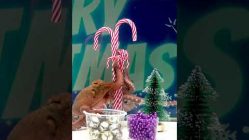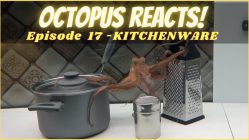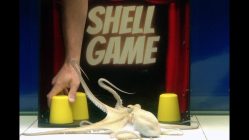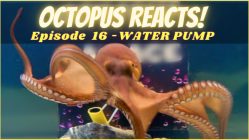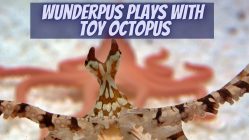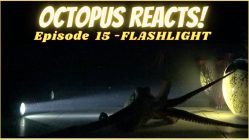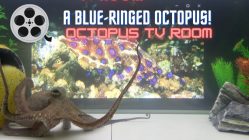The Request
This experiment was requested by Youtube user Daffney Dalilah, who wrote:
”It would be interesting to see if their reactions to objects is perhaps partly influenced by how it feels. And do different octopuses have different individual preferences as to which texture they favor?
Have 3 blocks of the same size and color, but each with a different texture (soft and fuzzy, smooth, bumpy). They would need to be heavy enough to sit at the bottom of the tank, but light enough to be picked up by the octopus. Line each one up in the tank, leaving enough space between each one so that the octopus can explore each one by touching it, playing with it, etc..
Keeping each object the same shape, color, size and weight would show that they are only showing different levels of interest to different objects based only on their texture. To further demonstrate that there are no other variables influencing behavior, the blocks would need to be placed in a different order each time to rule out the possibility of them giving preference to any certain one based on placement.
I think that each octopus will recognize the difference in textures by displaying a differing reaction to each one. I believe this will give further proof to the fact that each octopus is his or her own individual by showing that not every octopus shows favoritism to the same texture.
I think each octopus is going to show preference to which ever texture they enjoy more or are more comfortable with (in this case, lets say it’s the bumpy block) by either:
1 – Going for the bumpy one first
2 – Spending more time with the bumpy one than the other textured blocks
3 – Playing with the bumpy one more than the other two
Or maybe even all 3 of these
I am thinking that the smooth one will be less likely to be a favorite because I feel like an animal with as much intelligence as an octopus is going to favor something that most intrigues it’s senses…in this case it’s sense of touch.”
Setting Up the Experiment
We found three equally sized cubes, not too heavy nor too light, and used black, non-toxic cloth to dress them. We added small, various-sized rocks to the surface of one cube to make it bumpy and non-toxic fur to make the other one soft and fuzzy. Then we placed the cubes in the observation tank in a random order, trying to keep an equal distance between them.
We were interested to see if our viewer was right to believe that Arnold will demonstrate a clear preference for the bumpy block. Her hypothesis made sense, as octopuses are familiar with bumpy surfaces which they encounter so often on the sea floor.
Arnold’s First Response
As soon as Arnold came out of his beloved barrel and spotted the black blocks, he immediately changed the shade of his color to a darker one. Then, after a short observation period, he ventured forth to explore the strange items presented to him. The first block on his way was the bumpy one but Arnold, after an indifferent stroke with his arm, swam past it and headed straight to the fuzzy one. We were absolutely astonished with what we saw next!
Arnold embraced the fuzzy block with all his arms and begun feeling it with his suckers. Every cell of his suckers seemed to jitter in excitement. It looked as if Arnold was tickled, and he definitely seemed to enjoy this unfamiliar sensation. It was like seeing a baby hugging a fluffy stuffed toy for the first time ever. It took Arnold half a minute to proceed to the flat block which he only examined for a few seconds before returning to his soft, furry, new friend for a reexamination. At this point, Arnold feigned an attack, perhaps to see if the block would be intimidated enough to move.
The Octopus Evaluates Before Making a Decision
As it is often the case, the wise Arnold moves away from the blocks to carefully consider the information he has collected.
When he revisits the blocks, however, he appears to have made up his mind about which one is his favourite. While he extends some of his arms to the other two blocks to feel them once more, his affections are clearly directed towards the fuzzy block, which he enfolds in his arms. When he returns to the safety of his barrel, we seize the opportunity to rotate the position of the blocks to see if this change will somewhat affect him when he decides to revisit the blocks.
Arnold Surprises Us Once Again…
Truth be told, Arnold’s enthusiasm for the fuzzy block influenced our expectations. We were almost convinced that at some point he would try to move the fuzzy block towards the barrel.
But Arnold is quite the opposite of an animal with predictable behaviour. Changing the position of the blocks had no dramatic effect on him. Each time he felt the blocks, as if to understand what went where, but he never again demonstrated a weird reaction or strong sentiment over a block. In fact, after some point he lost interest entirely and stopped paying attention to them altogether.
His behaviour made us wonder why the fuzzy block initially provoked such a strong reaction.
Was it because this texture was completely unfamiliar to him? Did he think the fur was hiding food? Perhaps it reminded him of a sea urchin? Or was it simply the fact that this texture did not allow his suckers to fully stick onto this surface?
All these questions led us to decide that we will certainly revisit this experiment in the future, this time with a different octopus. Only in this way will we be more able to speculate about the way the octopus perceives different textures and if they indeed favor some kinds of textures over others.


